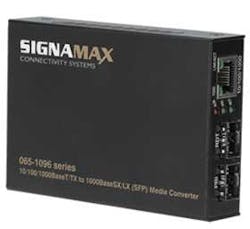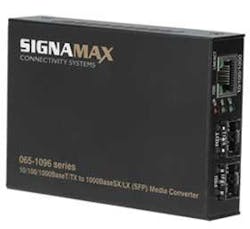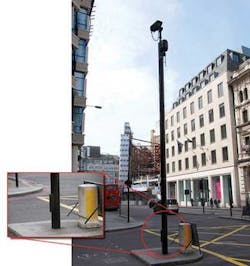Media converters for changing technologies
Ruggedized designs, SFP ports, and heavy software engineering are now hallmarks of versatile networking devices.
When media converters emerged as frequentlydeployed technologies inenterprise networks in the late 1990s, the common belief was they would be a temporary part of the landscape. The media converter's primary purpose would be tofacilitate fiber-to-the-desk architectures, lettingusers gain the benefits of optical communications to the desktop without immediately having to replace their copper-based network interface cards (NICs) withoptical-based NICs. Eventually, many believed, users would adopt fiber NICs and media converters would go by the wayside. In that respect, they might be compared to the balun of a few networking generations earlier, which was used to connect balanced twisted-pair media with unbalanced coaxial media in cabling systems—thus, its name from that capability.
As it turns out, neither the balun nor the media converter has gone extinct or even become endangered. Lately, the balun has re-emerged in some security networks, where users are beginning to migrate their videoinfrastructure from coaxial cabling to twisted-pair copper cabling reminiscent of the balun's earlierappearances in data networks. And the mediaconverter remains a widely deployed networking device that allows user organizations of several types to do far more than migrate their to-the-desktop medium.
Beyond fiber-to-the-desk
That's not to say media converters did not serve the original notion of their purpose. According to Ron Thompson, director of systems development and training with Signamax Connectivity Systems (www.signamax.com), “We find military and other U.S.-government markets haveembraced the idea of using media converters in lieu of afiber NIC. Operationally, they're able to maintain a consistent environment,” by keeping their built-in copper-based NICs, he explains. With media converters, “there is no need to add to the confusion or workload for an ITdepartment because you can plug and play. With fiber NICs, you have to be concerned with driver support and the continued availability of chipsets.”
Transition Networks (www.transition.com), like Signamax, offers fiber NICs as well as media converters. Transition's director of marketing, Pat Schaber, says lines get drawn concerning when one device is preferable over the other. “In applications that require the utmost security, the fiber NIC is imperative,” he states. “Media conversion continues to offer the value proposition of allowing users to leverage fiber. Manufacturers in the space have advanced the technology, including the building in of intelligence and management capabilities.”
Ty Estes, Omnitron Systems Technology's (www.omnitron-systems.com) director of marketing communications, continues the theme: “The management being integratedinto media converters is enabling them to act as compact switches. They are replacing 2- or 3-port switchesin some environments, and are particularlyhelpful in campus networks. Some school districts, for example, are leasing fiber from service providers and running Gigabit Ethernet,” while using media converters rather than switches to accomplish their objectives.
Dave Zaveski, senior sales engineer with IMC Networks(www.imcnetworks.com), concurs that switch-style connectivity and, in particular, virtual local area network (VLAN) tech-nology are driving some of today's media converter use. “We're putting VLAN technologies intoour media converters; I call it ‘Layer 2.5,'” he says, referring to the OSI 7-layer model of network-protocol design. Layer 1 of that model is physical; Layer 2 is data link; Layer 3 is network. Zaveski says the capability going into media converters today is “a little more than just Layer 2, but not quite Layer 3 technology either.”
The earlier reference to baluns' resurgence in security networks also applies on some level to media conversion. As Internet Protocol-based (IP) surveillance cameras have grown in popularity, the media converter has been able to meet the dual needs of some IP-camera users who require the long distance connectivity capabilities of fiber as well as the Power over Ethernet (PoE) capabilities that accompany twisted-pair copper solutions.
“We see PoE as a very strong growth area,” says Transition's Schaber. “With the proliferation of IP video as well as IP phones, there has been a lot of growth. The conversion from analog to IP video has not happened as rapidly as some were predicting a few years ago, but interest in the technology has grown over the last year-plus especially. A lot of these cameras are not at copper-permitted distances, and media converters allow users to combine power and data without an extra power run.”
Often in these cases, the PoE-capable camera is locatedoutdoors, thereby requiring the camera and any devices alongside it to stand up to harsh conditions. Converter manufacturers take different approaches to meeting these needs. IMC's Zaveski says, “We find that about 90% of the users looking for hardened devices really only need extended-temperature performance. A true hardened device also provides vibration dampening, mist control, and other characteristics.” IMC does not offer true hardened devices in that respect.Zaveski continues, “We do extended temperature. As long as the device is in anenvironmentally safe box, the user is fine.”
He adds, “I see that kind of external-environment use growing rapidly. Users are putting network devices everywhere.” One such place is on city streets, where Zaveski says IMC devices have been used in environmentally protected housings at suchlocations as streetlights and traffic signals.
New territory
Signamax's Thompson sgrees deployment in the automobile-traffic area is an example of settings in which media converters are used today but where they would not be seen a few years ago. In Systimax's case, the media converter itself is hardened to withstand the rigors of exterior placement. “One application for media converters that many were not even thinking about five or ten years ago is traffic cameras,” Thompson says. “Think of an intersection with eight cameras and switch controlling. To go fully around the intersection, you'll need media conversion because of the total distance” of link lengths among all eight cameras.
“We have seen dramatic growth in the market for hardened converters,” Thompson notes. Omnitron's Estes backs up that statement, saying that a significant reason for the increased market for hardened converters is the use of media conversion technology by communications service providers as they push fiber closer to customer premises environments, whether those customers are residential or business. In Verizon'sfiber-to-the-home deployments, for example, media conversion technology serves as the interface device between the service provider's network and the customer's. Similarly, business users of higher-speedconnections, such as Metro Ethernet, from their service providers have media conversion deployed at the demarcation point.
“A customer might buy a service from AT&T, such as a Gigabit Ethernet connection between offices in Los Angeles and New York,” Estes explains, “But it is wholesaled through two different operators to build the circuit. The newest network-interface devices with media-conversion capability have on-board processors that allow traffic shaping and other functionality. They have capabilities to support new specifications from ITU[International Telecommunications Union] and IEEE [Institute of Electrical and Electronics Engineers], which enable them to monitor the link and service itself. Capabilities like fault detection are being built into Ethernet equipment.”
With this level of capability, “the so-called lowly media converter has evolved into a sophisticated tool,” Estes asserts. “We used to be a company filled with hardware engineers; now, we're almost entirely software engineers.”
An SFP world
One category of hardware that looks to play a significant role in the future of media conversion is the small-form pluggable (SFP) transceiver module. “SFP is not really new technology, but a technology that is really taking hold,” says IMC'sZaveski. “We see a lot of requests from people who want LC connectors. Rather than getting fixed fibers with LCs on them, we are putting into our converters SFPs with LCs on them. For many reasons, we're moving toward the SFP, and it's probably one of the biggest influences shaping our products.”
Thompson echoes the sentiment: “Gig Ethernet is growing to the point where it becomes a really good idea to have SFP modules placed in media converters. It reduces everybody'sinventory throughout the manufacturing and distribution chain, and makes changes easier.”
Estes adds, “Ten years ago, we heard that media converters would go away as switches became more modern and interfaces got standardized. But even today, the customer handoff requires media conversion. Our 10-Gig device has SFP ports on both ends. One of those ports could be filled with the copper-based CX4 10-Gig solution. The user doesn't have to buy 50 different specialized devices. They can buy SFP converters instead.”
The flexibility that is characteristic of the SFP module has also proven to be a characteristic of media conversion technology. Once viewed by many as a stopgap solution whose day would come and go, the media converter appears to have a bright future in networking.
Patrick McLaughlin is chief editor of Cabling Installation & Maintenance.


